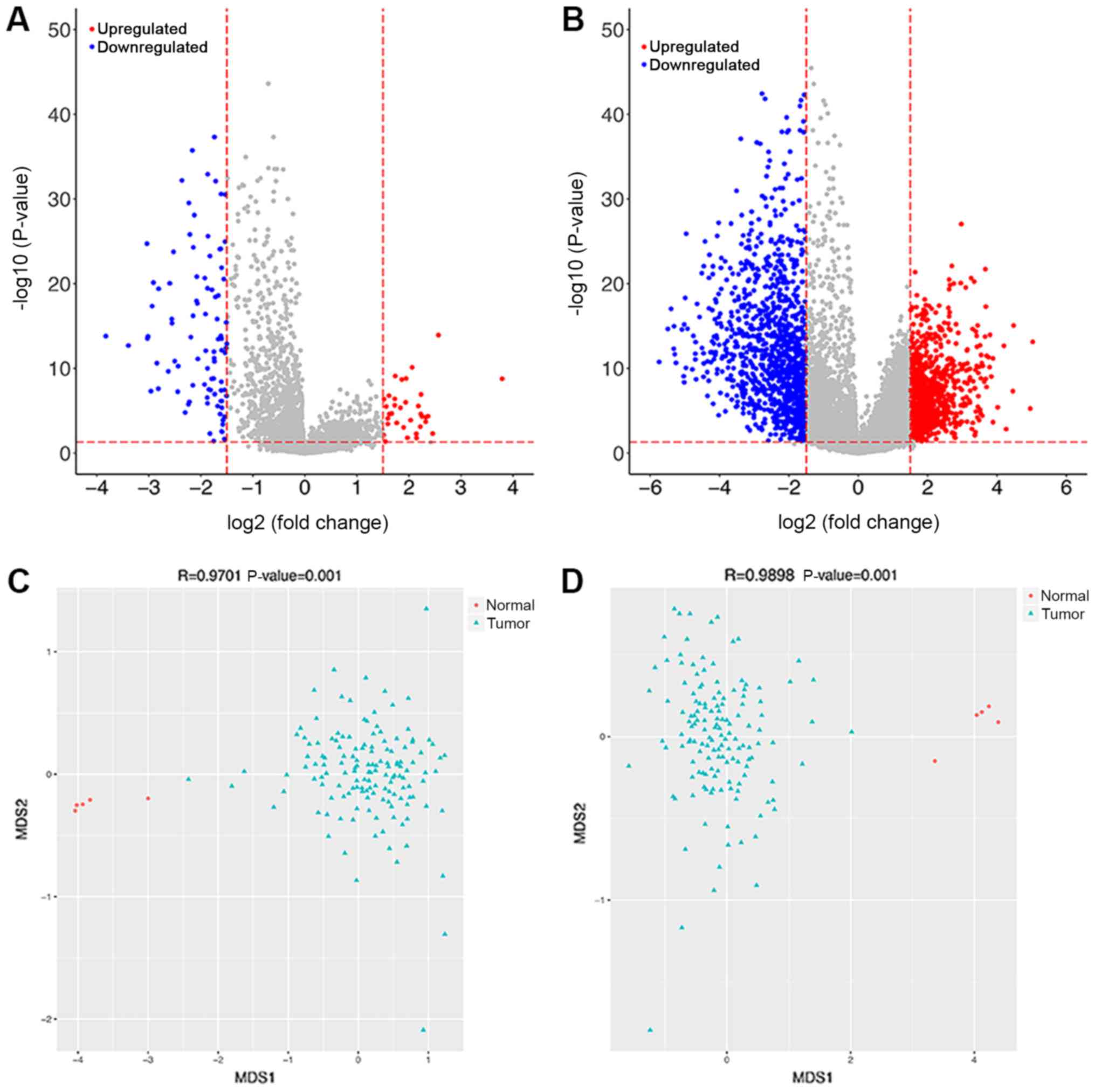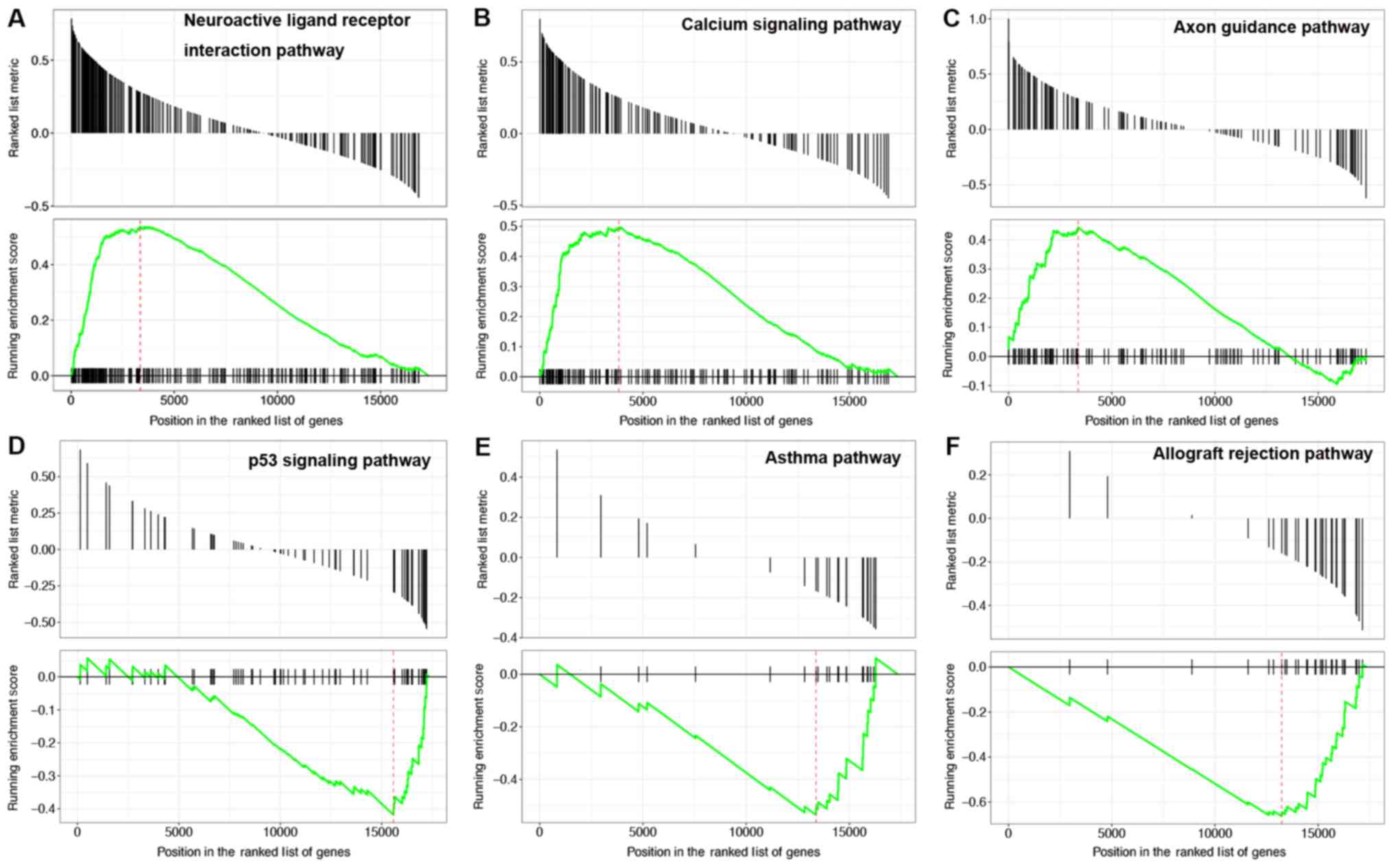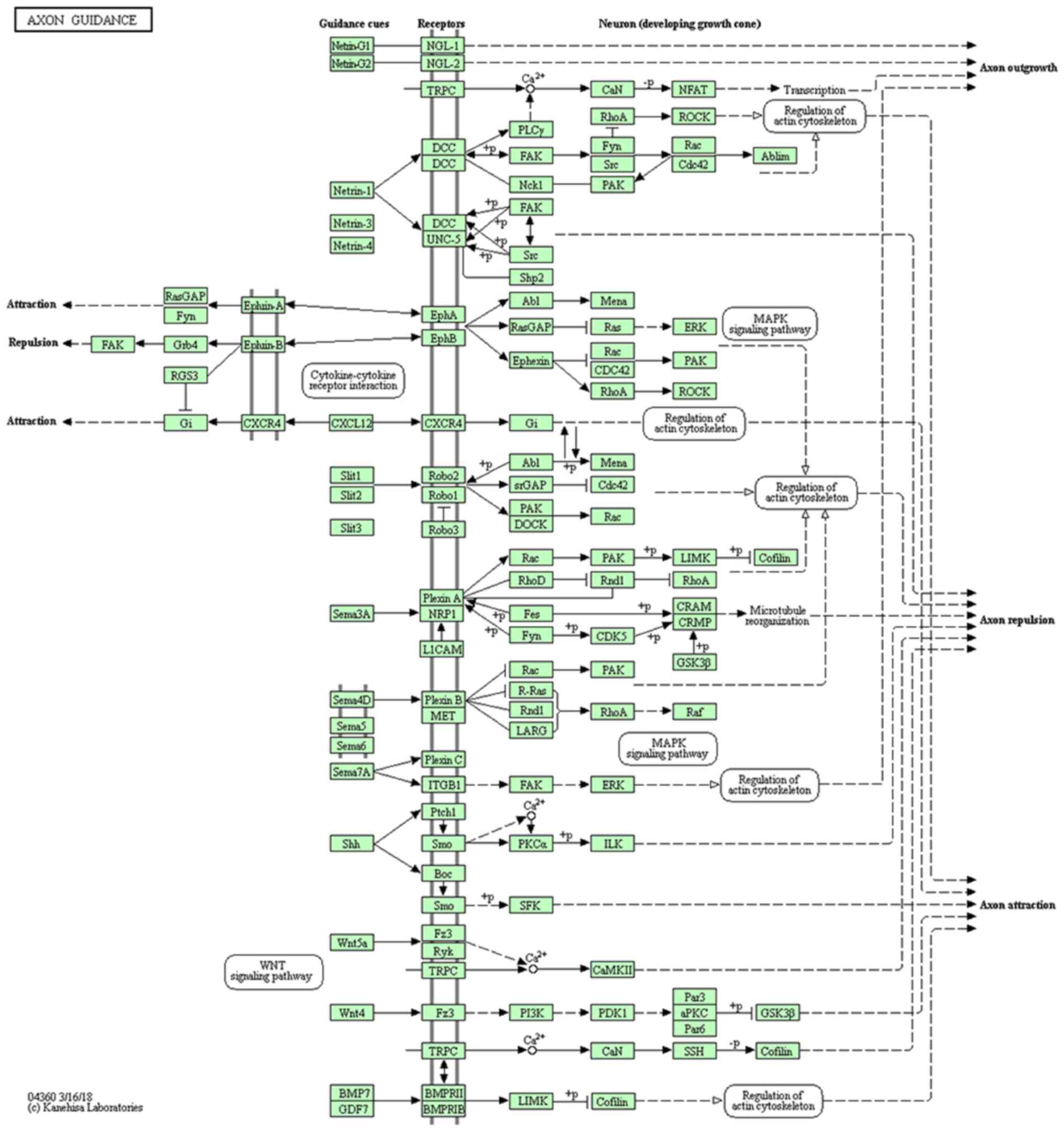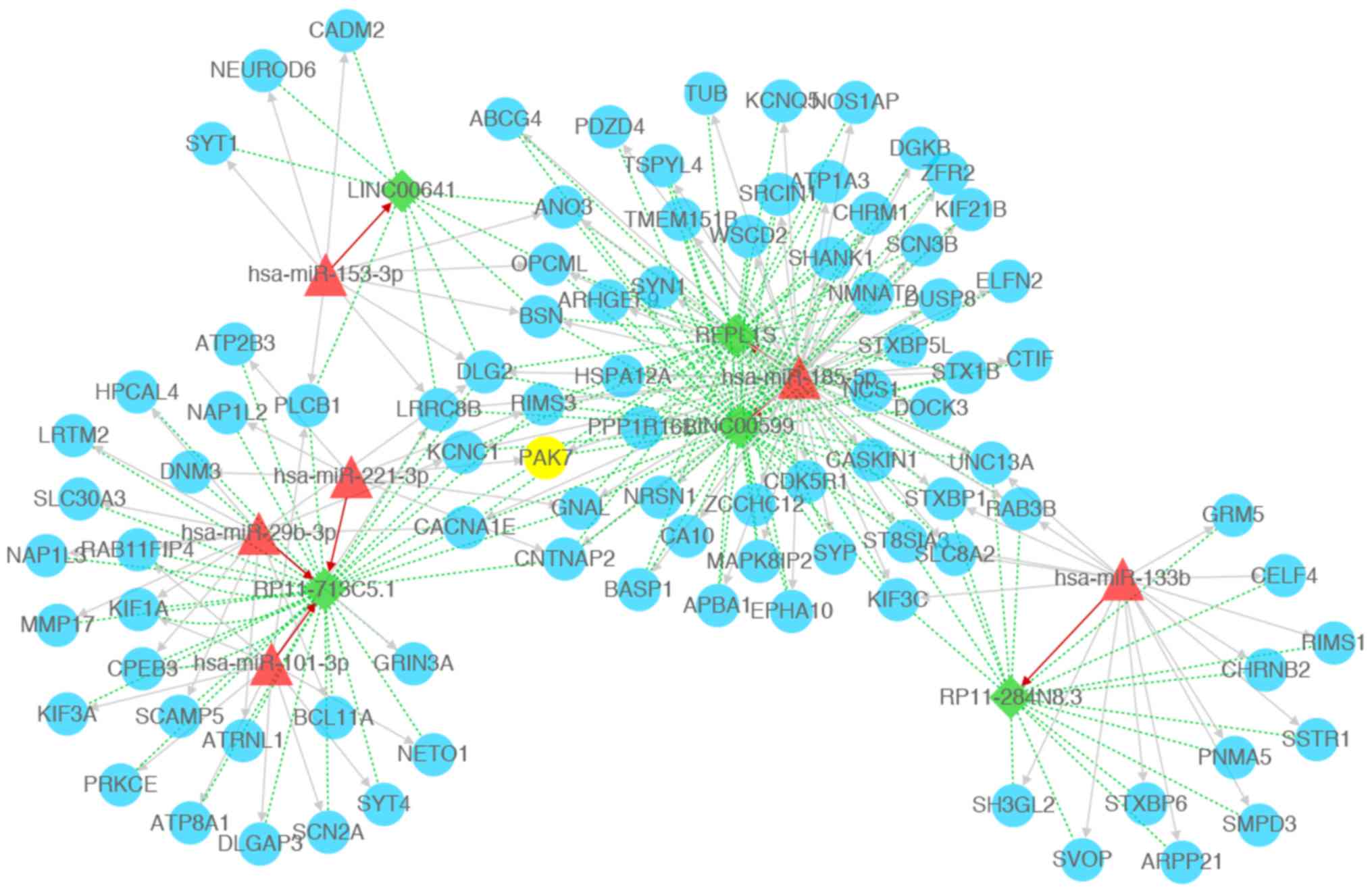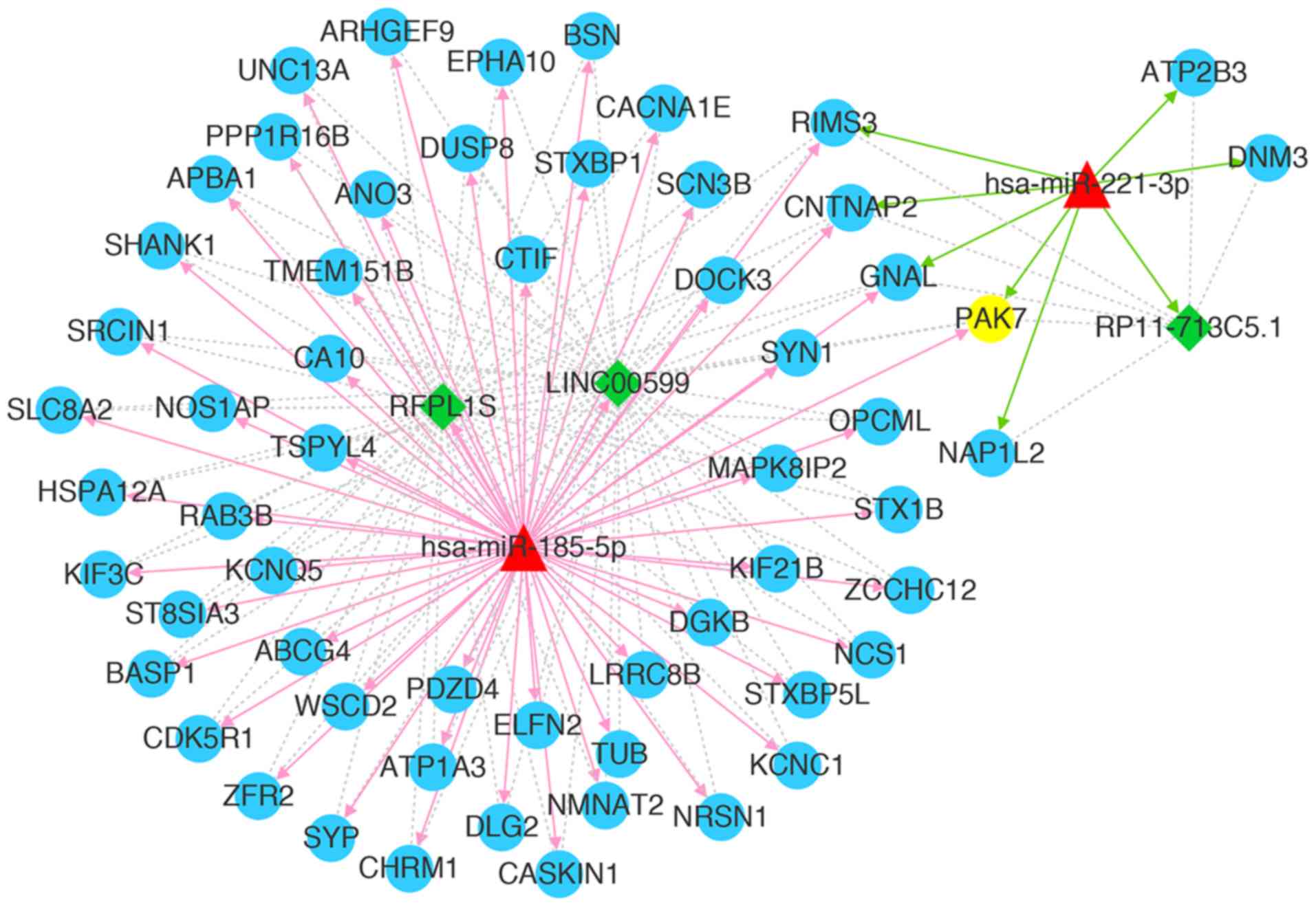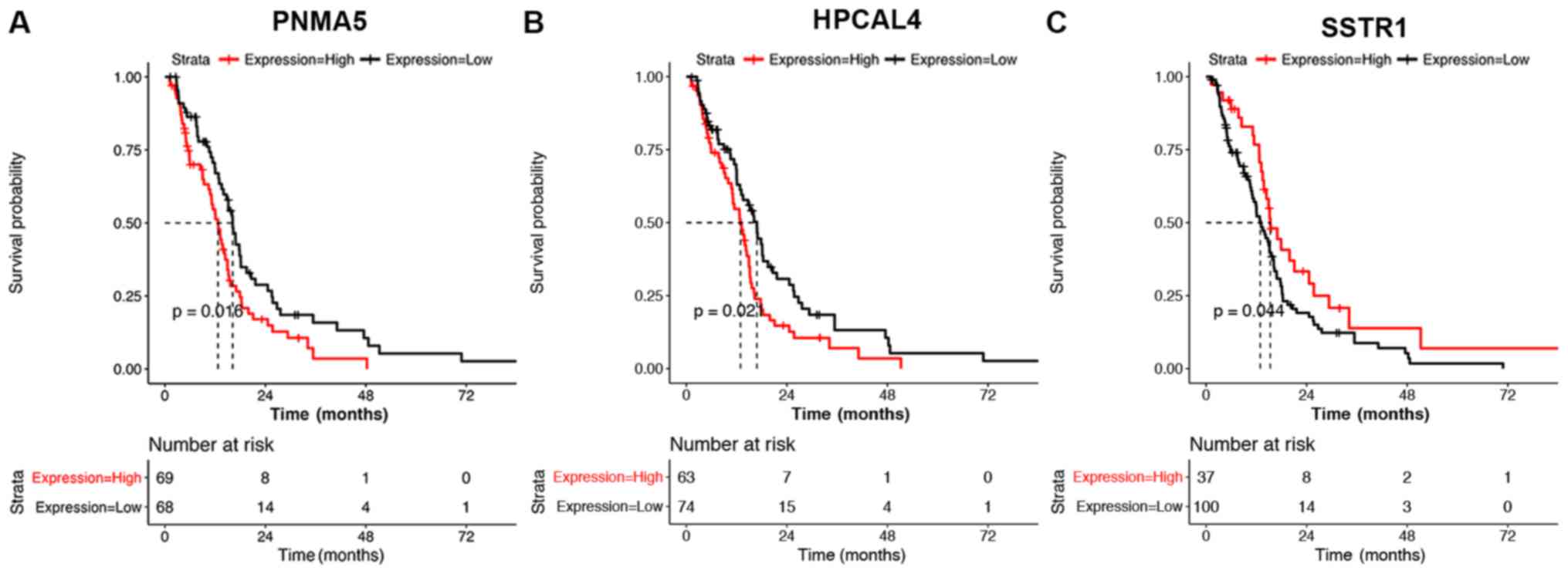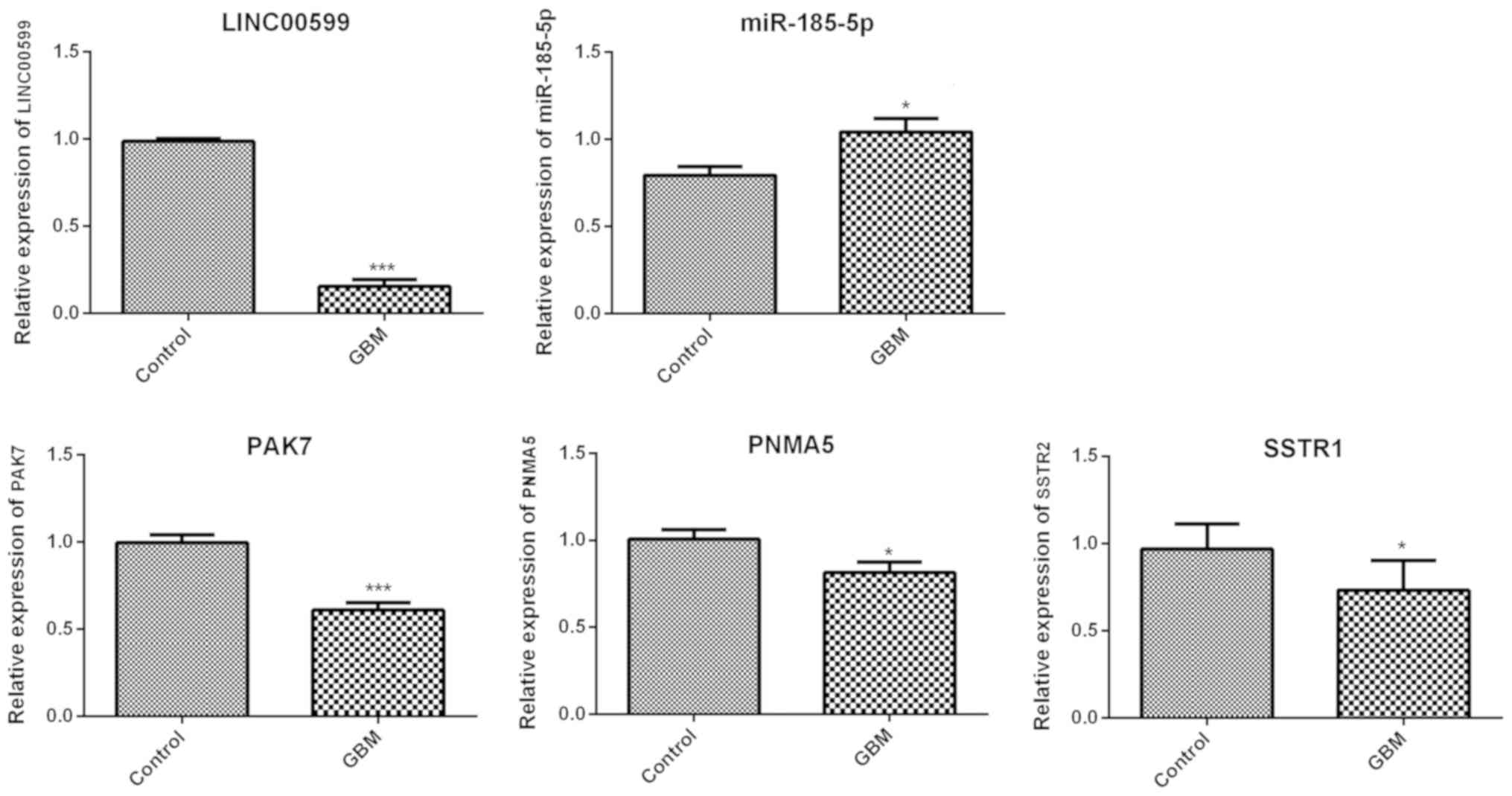|
1
|
Ostrom QT, Gittleman H, Farah P, Ondracek
A, Chen Y, Wolinsky Y, Stroup NE, Kruchko C and Barnholtz-Sloan JS:
CBTRUS statistical report: Primary brain and central nervous system
tumors diagnosed in the United States in 2006–2010. Neuro Oncol. 15
(Suppl 2):ii1–ii56. 2013. View Article : Google Scholar : PubMed/NCBI
|
|
2
|
Young RM, Jamshidi A, Davis G and Sherman
JH: Current trends in the surgical management and treatment of
adult glioblastoma. Ann Transl Med. 3:1212015.PubMed/NCBI
|
|
3
|
Nam JY and de Groot JF: Treatment of
glioblastoma. J Oncol Pract. 13:629–638. 2017. View Article : Google Scholar : PubMed/NCBI
|
|
4
|
Gallego O: Nonsurgical treatment of
recurrent glioblastoma. Curr Oncol. 22:e273–e281. 2015. View Article : Google Scholar : PubMed/NCBI
|
|
5
|
Bo LJ, Wei B, Li ZH, Wang ZF, Gao Z and
Miao Z: Bioinformatics analysis of miRNA expression profile between
primary and recurrent glioblastoma. Eur Rev Med Pharmacol Sci.
19:3579–3586. 2015.PubMed/NCBI
|
|
6
|
Guo Q, Zhang M, Hu G, Dai Y, Liu D and Yu
S: Bioinformatics analysis of differentially expressed genes in
glioblastoma. Acta Med Univ Sci Technol Huazhong. ((Issue 1)):
38–43. 2018.(In Chinese).
|
|
7
|
Gu X, Wang C, Wang X, Ma G, Li Y, Cui L,
Chen Y, Zhao B and Li K: Efficient inhibition of human glioma
development by RNA interference-mediated silencing of PAK5. Int J
Biol Sci. 11:230–237. 2015. View Article : Google Scholar : PubMed/NCBI
|
|
8
|
Rane CK and Minden A: P21 activated
kinases: Structure, regulation, and functions. Small GTPases.
5(pii): e280032014. View Article : Google Scholar : PubMed/NCBI
|
|
9
|
Dan C, Nath N, Liberto M and Minden A:
PAK5, a new brain-specific kinase, promotes neurite outgrowth in
N1E-115 cells. Mol Cell Biol. 22:567–577. 2002. View Article : Google Scholar : PubMed/NCBI
|
|
10
|
Pandey A, Dan I, Kristiansen TZ, Watanabe
NM, Voldby J, Kajikawa E, Khosravi-Far R, Blagoev B and Mann M:
Cloning and characterization of PAK5, a novel member of
mammalianp21-activated kinase-II subfamily that is predominantly
expressed in brain. Oncogene. 21:3939–3948. 2002. View Article : Google Scholar : PubMed/NCBI
|
|
11
|
Han ZX, Wang XX, Zhang SN, Wu JX, Qian HY,
Wen YY, Tian H, Pei DS and Zheng JN: Downregulation of PAK5
inhibits glioma cell migration and invasion potentially through the
PAK5-Egr1-MMP2 signaling pathway. Brain Tumor Pathol. 31:234–241.
2014. View Article : Google Scholar : PubMed/NCBI
|
|
12
|
Zhai J, Qu S, Li X, Zhong J, Chen X, Qu Z
and Wu D: miR-129 suppresses tumor cell growth and invasion by
targeting PAK5 in hepatocellular carcinoma. Biochem Biophys Res
Commun. 464:161–167. 2015. View Article : Google Scholar : PubMed/NCBI
|
|
13
|
Harrow J, Frankish A, Gonzalez JM,
Tapanari E, Diekhans M, Kokocinski F, Aken BL, Barrell D, Zadissa
A, Searle S, et al: GENCODE: The reference human genome annotation
for The ENCODE project. Genome Res. 22:1760–1774. 2012. View Article : Google Scholar : PubMed/NCBI
|
|
14
|
Quadrianto N and Buntine WL: Linear
regression. Encyclopedia of Machine Learning. Springer. (Boston,
MA). 2016.
|
|
15
|
Koop G: Bayesian methods for empirical
macroeconomics with big data. Rev Econ Anal. 9:33–56. 2017.
|
|
16
|
Smyth GK: Limma: Linear models for
microarray data. Bioinformatics and Computational Biology Solutions
Using R and Bioconductor. Statistics for Biology and Health, .
Gentleman R, Carey VJ, Huber W, Irizarry RA and Dudoit S: Springer;
New York, NY: pp. 397–420. 2005, View Article : Google Scholar
|
|
17
|
Benjamini Y and Hochberg Y: Controlling
the false discovery rate: A practical and powerful approach to
multiple testing. J Roy Stat Soc B. 57:289–300. 1995.
|
|
18
|
Yekti YND and Yassierli: Kansei
engineering using non-metric multidimensional scaling (NMDS) and
cluster analysis methods. Seanes International Conference on Human
Factors and Ergonomics in South-East Asia. 2016.
|
|
19
|
Oksanen J, Blanchet F, Kindt R, Legendre
P, Minchin R, O'Hara R, Oksanen J, Blanchet FG, Kindt R, Legendre
P, et al: vegan: Community ecology package version 2.0–10. J Stat
Softw. 48:103–132. 2013.
|
|
20
|
Clark KR: Non-parametric multivariate
analysis of changes in community structure. Aust J Ecol.
18:117–143. 1993. View Article : Google Scholar
|
|
21
|
Kanehisa M, Sato Y, Furumichi M, Morishima
K and Tanabe M: New approach for understanding genome variations in
KEGG. Nucleic Acids Res. 47(D1): D590–D595. 2019. View Article : Google Scholar : PubMed/NCBI
|
|
22
|
Yu G, Wang LG, Han Y and He QY:
clusterProfiler: An R package for comparing biological themes among
gene clusters. OMICS. 16:284–287. 2012. View Article : Google Scholar : PubMed/NCBI
|
|
23
|
Breuer K, Foroushani AK, Laird MR, Chen C,
Sribnaia A, Lo R, Winsor GL, Hancock RE, Brinkman FS and Lynn DJ:
InnateDB: Systems biology of innate immunity and beyond-recent
updates and continuing curation. Nucleic Acids Res. 41((Database
Issue)): D1228–D1233. 2013. View Article : Google Scholar : PubMed/NCBI
|
|
24
|
Dweep H and Gretz N: miRWalk2.0: A
comprehensive atlas of microRNA-target interactions. Nat Methods.
12:6972015. View Article : Google Scholar : PubMed/NCBI
|
|
25
|
Moreno R, Miranda DR, Fidler V and Van SR:
Evaluation of two outcome prediction models on an independent
database. Crit Care Med. 26:50–61. 1998. View Article : Google Scholar : PubMed/NCBI
|
|
26
|
Wang X: miRDB: A microRNA target
prediction and functional annotation database with a wiki
interface. RNA. 14:1012–1017. 2008. View Article : Google Scholar : PubMed/NCBI
|
|
27
|
Vejnar CE and Zdobnov EM: MiRmap:
Comprehensive prediction of microRNA target repression strength.
Nucleic Acids Res. 40:11673–11683. 2012. View Article : Google Scholar : PubMed/NCBI
|
|
28
|
Miranda K, Huynh T, Tay Y, Ang YS, Tam WL,
Thomson AM, Lim B and Rigoutsos I: A pattern-based method for the
identification of MicroRNA binding sites and their corresponding
heteroduplexes. Cell. 126:1203–1217. 2006. View Article : Google Scholar : PubMed/NCBI
|
|
29
|
Grimson A, Farh KK, Johnston WK,
Garrett-Engele P, Lim LP and Bartel DP: MicroRNA targeting
specificity in mammals: Determinants beyond seed pairing. Mol Cell.
27:91–105. 2007. View Article : Google Scholar : PubMed/NCBI
|
|
30
|
Li JH, Liu S, Zhou H, Qu LH and Yang JH:
starBase v2.0: Decoding miRNA-ceRNA, miRNA-ncRNA and protein-RNA
interaction networks from large-scale CLIP-Seq data. Nucleic Acids
Res. 42((Database Issue)): D92–D97. 2014. View Article : Google Scholar : PubMed/NCBI
|
|
31
|
Das S, Ghosal S, Sen R and Chakrabarti J:
lnCeDB: Database of human long noncoding RNA acting as competing
endogenous RNA. PLoS One. 9:e989652014. View Article : Google Scholar : PubMed/NCBI
|
|
32
|
Alberti C, Timsit JF and Chevret S:
Survival analysis-the log rank test. Rev Mal Respir. 22:829–832.
2005.(In French). View Article : Google Scholar : PubMed/NCBI
|
|
33
|
Bland JM and Altman DG: Survival
probabilities (the Kaplan-Meier method). BMJ. 317:15721998.
View Article : Google Scholar : PubMed/NCBI
|
|
34
|
Livak KJ and Schmittgen TD: Analysis of
relative gene expression data using real-time quantitative PCR and
the 2(-Delta Delta C(T)) method. Methods. 25:402–408. 2001.
View Article : Google Scholar : PubMed/NCBI
|
|
35
|
Ni Y, Zhang F, An M, Yin W and Gao Y:
Early candidate biomarkers found from urine of glioblastoma
multiforme rat before changes in MRI. Sci China Life Sci.
61:982–987. 2018. View Article : Google Scholar : PubMed/NCBI
|
|
36
|
Wei B, Wang L, Du C, Hu G, Wang L, Jin Y
and Kong D: Identification of differentially expressed genes
regulated by transcription factors in glioblastomas by
bioinformatics analysis. Mol Med Rep. 11:2548–2554. 2015.
View Article : Google Scholar : PubMed/NCBI
|
|
37
|
Zhang Y, Xia Q and Lin J: Identification
of the potential oncogenes in glioblastoma based on bioinformatic
analysis and elucidation of the underlying mechanisms. Oncol Rep.
40:715–725. 2018.PubMed/NCBI
|
|
38
|
Liu M, Xu Z, Du Z, Wu B, Jin T, Xu K, Xu
L, Li E and Xu H: The identification of key genes and pathways in
glioma by bioinformatics analysis. J Immunol Res. 2017:12780812017.
View Article : Google Scholar : PubMed/NCBI
|
|
39
|
Suter TACS, DeLoughery ZJ and Jaworski A:
Meninges-derived cues control axon guidance. Dev Biol. 430:1–10.
2017. View Article : Google Scholar : PubMed/NCBI
|
|
40
|
Agrawal R, Chugh C, Mukherji JD and Singh
P: Acute axonal polyneuropathy following resection of a
glioblastoma multiforme. Neurol India. 65:1422–1423. 2017.
View Article : Google Scholar : PubMed/NCBI
|
|
41
|
Pace KR, Dutt R and Galileo DS: Exosomal
L1CAM stimulates glioblastoma cell motility, proliferation, and
invasiveness. Int J Mol Sci. 20(pii): E39822019. View Article : Google Scholar : PubMed/NCBI
|
|
42
|
Huang Y, Tejero-Villalba R, Kesari S, Zou
H and Friedel R: ANGI-19. The axon guidance receptor Plexin-B2
promotes tumorigenicity of glioblastoma. Neuro Oncol. 19 (Suppl
6):vi252017. View Article : Google Scholar
|
|
43
|
Kunapuli P, Lo K, Hawthorn L and Cowell
JK: Reexpression of LGI1 in glioma cells results in dysregulation
of genes implicated in the canonical axon guidance pathway.
Genomics. 95:93–100. 2010. View Article : Google Scholar : PubMed/NCBI
|
|
44
|
Wang G, Song Y, Liu T, Wang C, Zhang Q,
Liu F, Cai X, Miao Z, Xu H, Xu H, et al: PAK1-mediated MORC2
phosphorylation promotes gastric tumorigenesis. Oncotarget.
6:9877–9886. 2015. View Article : Google Scholar : PubMed/NCBI
|
|
45
|
He LF, Xu HW, Chen M, Xian ZR, Wen XF,
Chen MN, Du CW, Huang WH, Wu JD and Zhang GJ: Activated-PAK4
predicts worse prognosis in breast cancer and promotes
tumorigenesis through activation of PI3K/AKT signaling. Oncotarget.
8:17573–17585. 2016. View Article : Google Scholar
|
|
46
|
Roberts JA: An investigation of the role
of PAK6 in tumorigenesis. Diss Theses Gradworks. 2012.
|
|
47
|
Hing H, Xiao J, Harden N, Lim L and
Zipursky SL: Pak functions downstream of Dock to regulate
photoreceptor axon guidance in Drosophila. Cell. 97:853–863. 1999.
View Article : Google Scholar : PubMed/NCBI
|
|
48
|
Chen SY, Huang PH and Cheng HJ:
Disrupted-in-Schizophrenia 1-mediated axon guidance involves
TRIO-RAC-PAK small GTPase pathway signaling. Proc Natl Acad Sci
USA. 108:5861–5866. 2011. View Article : Google Scholar : PubMed/NCBI
|
|
49
|
Zhao Z, Ma X, Sung D, Li M, Kosti A, Lin
G, Chen Y, Pertsemlidis A, Hsiao TH and Du L: microRNA-449a
functions as a tumor suppressor in neuroblastoma through inducing
cell differentiation and cell cycle arrest. RNA Biol. 12:538–554.
2015. View Article : Google Scholar : PubMed/NCBI
|
|
50
|
Morrow C, Smirnov I, Adai A, Yeh RF,
Mistra A and Feuerstein B: MIR-185 is lost in glioblastoma
multiforme (GBM) and inhibits proliferation in glioma cell lines.
Meet Soc Neuro Oncol. 7672008.
|
|
51
|
Tang H, Liu Q, Liu X, Ye F, Xie X, Xie X
and Wu M: Plasma miR-185 as a predictive biomarker for prognosis of
malignant glioma. J Cancer Res Ther. 11:630–634. 2015. View Article : Google Scholar : PubMed/NCBI
|
|
52
|
Tang H, Wang Z, Liu X, Liu Q, Xu G, Li G
and Wu M: LRRC4 inhibits glioma cell growth and invasion through a
miR-185-dependent pathway. Curr Cancer Drug Targets. 12:1032–1042.
2012. View Article : Google Scholar : PubMed/NCBI
|
|
53
|
Paraskevopoulou MD and Hatzigeorgiou AG:
Analyzing MiRNA-LncRNA interactions. Methods Mol Biol.
1402:271–286. 2016. View Article : Google Scholar : PubMed/NCBI
|
|
54
|
Tran DDH, Kessler C, Niehus SE, Mahnkopf
M, Koch A and Tamura T: Myc target gene, long intergenic noncoding
RNA, Linc00176 in hepatocellular carcinoma regulates cell cycle and
cell survival by titrating tumor suppressor microRNAs. Oncogene.
37:75–85. 2018. View Article : Google Scholar : PubMed/NCBI
|
|
55
|
Amirkhah R, Schmitz U, Linnebacher M,
Wolkenhauer O and Farazmand A: MicroRNA-mRNA interactions in
colorectal cancer and their role in tumor progression. Genes
Chromosomes Cancer. 54:129–141. 2015. View Article : Google Scholar : PubMed/NCBI
|
|
56
|
Li Y, Xu J, Chen H, Bai J, Li S, Zhao Z,
Shao T, Jiang T, Ren H, Kang C and Li X: Comprehensive analysis of
the functional microRNA-mRNA regulatory network identifies miRNA
signatures associated with glioma malignant progression. Nucleic
Acids Res. 41:e2032013. View Article : Google Scholar : PubMed/NCBI
|
|
57
|
Song X, Xie Y, Liu Y, Shao M and Yang W:
MicroRNA-492 overexpression exerts suppressive effects on the
progression of osteosarcoma by targeting PAK7. Int J Mol Med.
40:891–897. 2017. View Article : Google Scholar : PubMed/NCBI
|
|
58
|
Pan YJ, Wei LL, Wu XJ, Huo FC, Mou J and
Pei DS: MiR-106a-5p inhibits the cell migration and invasion of
renal cell carcinoma through targeting PAK5. Cell Death Dis.
8:e31552017. View Article : Google Scholar : PubMed/NCBI
|
|
59
|
Impey S, Davare M, Lasiek A, Fortin D,
Ando H, Varlamova O, Obrietan K, Soderling TR, Goodman RH and
Wayman GA: An activity-induced microRNA controls dendritic spine
formation by regulating Rac1-PAK signaling. Mol Cell Neurosci.
43:146–156. 2010. View Article : Google Scholar : PubMed/NCBI
|
|
60
|
Lee YH, Pang SW, Poh CL and Tan KO:
Distinct functional domains of PNMA5 mediate protein-protein
interaction, nuclear localization, and apoptosis signaling in human
cancer cells. J Cancer Res Clin Oncol. 142:1967–1977. 2016.
View Article : Google Scholar : PubMed/NCBI
|
|
61
|
Teng XM, Deng Q, Han ZG and Huang J:
Expression of PNMA5 in hepatocellular carcinoma tissues and its
function. Tumor. 28:911–915. 2008.
|
|
62
|
Bruns C, Weckbecker G, Raulf F, Kaupmann
K, Schoeffter P, Hoyer D and Lübbert H: Molecular pharmacology of
somatostatin receptor subtypes. Ann N Y Acad Sci. 733:138–146.
1994. View Article : Google Scholar : PubMed/NCBI
|
|
63
|
Kiviniemi A, Gardberg M, Frantzén J,
Pesola M, Vuorinen V, Parkkola R, Tolvanen T, Suilamo S, Johansson
J, Luoto P, et al: Somatostatin receptor subtype 2 in high-grade
gliomas: PET/CT with (68)Ga-DOTA-peptides, correlation to
prognostic markers, and implications for targeted radiotherapy.
EJNMMI Res. 5:252015. View Article : Google Scholar : PubMed/NCBI
|
|
64
|
Gatti M, Pattarozzi A, Würth R, Barbieri F
and Florio T: Somatostatin and somatostatin receptors 1, 2 and 5
selective agonists inhibit C6 glioma cell growth in vitro and in
vivo: Analysis of activated intracellular pathways. Regulat
Peptides. 164:382010. View Article : Google Scholar
|















